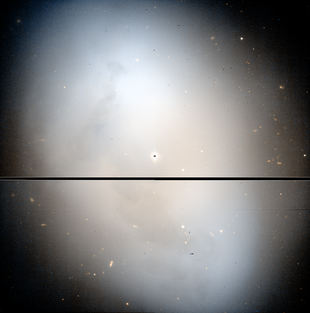NGC 1360
|
Planetary Nebula NGC 1360 |
|
|---|---|

|
|
| Image taken with the Very Large Telescope | |
| AladinLite | |
| Constellation | Chemical furnace |
|
Position equinox : J2000.0 |
|
| Right ascension | 03h 33m 14.6s |
| declination | -25 ° 52 ′ 18 ″ |
| Appearance | |
| Apparent brightness (visual) | +11.16 mag |
| Apparent brightness (B-band) | +10.95 likes |
| Angular expansion | 6.42 ′ × 6.42 ′ |
| Central star | |
| designation | HIP 16566 |
| Apparent brightness | 11.34 mag |
| Physical data | |
| Radial velocity | +41.8 km / s |
| distance | 1,278.2 + 42.7 / - 40.1 light years (391.9 + 13.1 / - 12.3 pc ) |
| history | |
| discovery | Lewis Swift |
| Date of discovery | 1859 |
| Catalog names | |
| NGC 1360 • PK 220-53.1 • ESO 482-PN7 • GC 5315 • AM 0331-260 | |
NGC 1360 is the name of a planetary nebula in the constellation Fornax . NGC 1360 has a magnitude of +9.4 mag and an angular expansion of 11.0 '× 7.5'. The planetary nebula is one of the objects with the most independent discoverers: The first observation was made by Lewis Swift in 1859. However, he did not publish this observation until 1885, so that the astronomers Ernst Wilhelm Leberecht Tempel (1861), Friedrich August Theodor Winnecke (1868) and Eugen Block (1879) found and described the object independently of one another.
NGC 1360 is an extensive planetary nebula about 350 pc distant without a sharply outlined envelope shape. Its envelope shape can be described by a prolate ellipsoid , with a main axis twice the length and an angle of 60 ° with respect to the line of sight. A kinematic age of around 10,000 years and a density of less than 130 hydrogen atoms per cubic centimeter were determined for the nebula. This suggests that the nebula is already dissolving and starting to mix with the non-stellar matter.
Web links
swell
- ↑ a b NASA / IPAC EXTRAGALACTIC DATABASE
- ^ SEDS
- ↑ a b SIMBAD
- ↑ Hipparcos
- ↑ Wolfgang Steinicke: Nebulae and star clusters: history of their discovery, observation and cataloging - from Herschel to Dreyer's "New General Catalog", p. 428
- ↑ Seligman
- ^ Daniel B. Goldman, Martín A. Guerrero, You-Hua Chu, Robert A. Gruendl: Physical structure of planetary nebulae. III. The large and evolved NGC 1360. , bibcode : 2004AJ .... 128.1711G